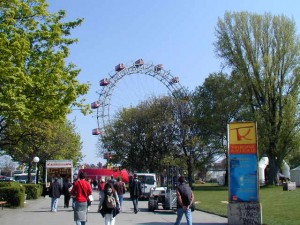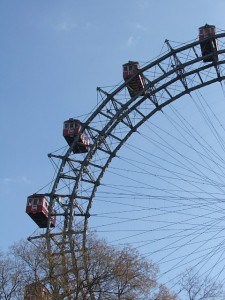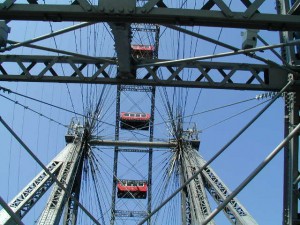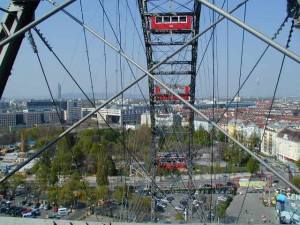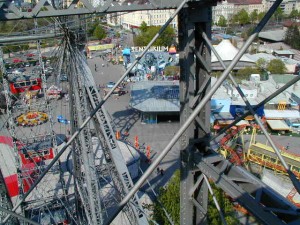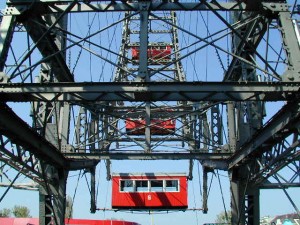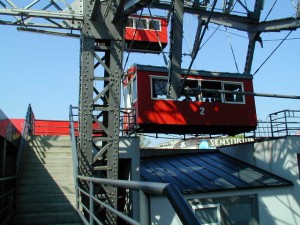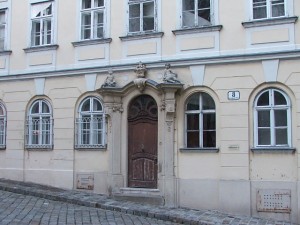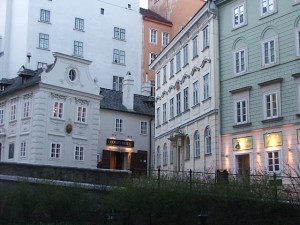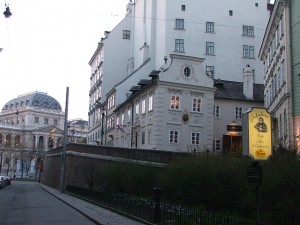2011-01-29: Some people say that a week is a long time in politics … but, here in Ireland, during the last two weeks … every single day feels like a year ! To the uninformed outside observer, this may have all the appearance of being an elaborate circus … but, we like our politics to be complex, interesting and very frothy.
Briefly … the Irish Green Party has recently removed itself, awkwardly, from the Ruling Coalition Government in this country … and the Green Party Agenda has gone up in smoke … definitely a Climate Changing Greenhouse Gas ! Mr. John Gormley T.D., Leader of the Green Party, has therefore resigned as Minister for the Environment, Heritage & Local Government … and his Green Party departmental colleague, Mr. Ciarán Cuffe T.D., Minister of State with special responsibility for Sustainable Transport, Horticulture, Planning and Heritage at the Departments of the Environment, Transport and Agriculture has also resigned.
With all of Ireland’s current economic woes … this decision by the Green Party has ensured that ‘Climate Change’ is fast dropping off the list of national priorities.
However, as a result of these political shenanigans … the word ‘Green’ has received a severe hammering and will induce a nasty taste in the mouths of many Irish Voters during the next few weeks which lead up to a General Election. To be honest, I heartily cheer this development … since ‘GREEN’-ness, i.e. a sole and blinkered consideration for the Environmental Aspects of Sustainability is a ‘pre-version’ (fans of the film: ‘Dr. Strangelove’ will understand what I mean) of Sustainable Human & Social Development. It is also a peculiar quirk of ‘greens’ that they love the environment … but hate people !
As a prelude to what I will say about the proposed enabling legislation for climate change action in Ireland … the 2010 Climate Change Response Bill … I thought that it would be interesting to reveal the contents of a submission I made to Mr. John Gormley back in late 2007. Concerning his reaction … I wondered how it was possible for anybody to write such a long letter in reply, and say nothing.
.
Mr. John Gormley T.D., 2007-12-18.
Minister for the Environment, Heritage & Local Government,
Department of the Environment, Heritage & Local Government (DEHLG),
Custom House – Dublin 1.
Re: Your Meeting with IIEA on Friday, 7th December 2007
Dear Minister,
At the Meeting with the Institute of International & European Affairs (IIEA), in North Great George’s Street, I raised two points directly with you:
i) The Great Difference between ‘Real’ Building Energy Performance and Claimed ‘Theoretical’ Performance. In a context where the mandatory use of long wave infra-red thermal imagery will not be introduced in the Revised Technical Guidance Document L of the Building Regulations, due to be issued shortly, and there will continue to be No Effective System of Building Control anywhere in the country … no relationship exists between Claimed ‘Theoretical’ Performance and ‘Real’ Performance, such is the poor quality of construction on Irish Building Sites. The Energy Numbers which continue to be produced by Sustainable Energy Ireland are – almost – pure fantasy.
ii) Sourcing of Climate Change Research & Models for Necessary Institutional Reform Must Extend Beyond Britain. The following is taken from the Irish National Climate Change Strategy 2007-2012 (page 45) …
‘ Ireland has also engaged in an exchange of information on impacts and adaptation activities through the British-Irish Council. This initiative has focused on exchanging data on research projects which have improved the understanding of climate change impacts at a local level.’
I suggested to you that if this were, actually, to be the approach to Research in Ireland … we will be in serious trouble. Furthermore, far too many people in important organizations (including the IIEA) are only looking across the water for Models of Necessary Institutional Reform. We must also, in Ireland, look to the rest of Europe and Japan to find the Best Research and the Most Effective Institutional Models.
Please see the enclosed World Business Council for Sustainable Development (WBCSD) Summary Report: ‘Energy Efficiency in Buildings – Business Realities & Opportunities’ (October 2007), which was presented at an important Paris Conference at the beginning of November, 2007.
This Report looks at what can be achieved in Europe and many other parts of the world – today – using currently available building technologies and systems … IF ‘real’ implementation is taken seriously. Barriers to progress and costs have also been examined.
In the final analysis, however, a properly resourced Indigenous Research Capability, focused on Irish Conditions and Needs, is vitally necessary to drive ‘Real’ Performance and Innovation in this country.
.
Post-Bali Leadership from Ireland (and DEHLG !)
A Kyoto II Instrument will be agreed and ratified before the end of 2012. The 1997 UNFCCC Kyoto Protocol must now be seen, therefore, as just the beginning of a long-term process which will last until the end of the century. Some Necessary Direction and a large pinch of Ethical Leadership are urgently required to properly re-position Ireland in this Process.
The following Post-Bali Target Scenario for Ireland is presented for your consideration:
- Ireland should set 1990 as the Benchmark/Base Year for All Kyoto Greenhouse Gases ;
- Statements of Measurement and Calculation Uncertainty should be fully transparent (nationally, and at EU level), and made at every stage of Ireland’s Kyoto Compliance ;
- The EU’s Objective of a 30% Reduction in Greenhouse Gases by 2020, compared to 1990, is the Relevant Short Term Target (refer to Paragraph 31 of the German Presidency Conclusions from the E.U. Council’s Brussels Summit on 8th and 9th March 2007) ;
- As our ‘Real’ Performance, under Kyoto I, continues to be so weak and disingenuous … we should not expect to receive as generous an intra-EU burden sharing arrangement as before. Instead, Ireland should adopt the 2020 National Target of a similar 30% Reduction in Greenhouse Gases, compared to 1990 ;
- Our Contingency Target for 2020 should be a 33% Reduction in Greenhouse Gases, compared to 1990. When considering ‘real’ performance in any field of human endeavour, it is usual to include a safety factor in any calculations …. in this case, 3% ;
- Ireland’s Recourse to the Use of Carbon Sinks and Kyoto Mechanisms in meeting the 2020 Contingency Target should be restricted to 1/4 of ‘Real’ Performance …
- ‘Real’ Performance (no sinks/mechanisms) – minimum 24% Reduction in Greenhouse Gases by 2020, compared to 1990 ;
- Use of Carbon Sinks and Kyoto Mechanisms – 9% Reduction in Greenhouse Gases by 2020, compared to 1990 (this figure includes the contingency 3%) ; and
- As the Construction Sector (when properly identified) should share more of the national burden than, for example, Agriculture …. its Target should be a 40% Reduction in Greenhouse Gases by 2020, compared to 1990. Remember the range of reductions which were initially proposed at Bali …. 25-40% ?
- Part 1 of SDI’s Submission for the Irish Construction Sector (IIEA Climate Change Project, Sectors Sub-Group – June 2007) stressed the great need to properly restore the Construction Sector’s Infrastructure. Otherwise, this Sector will not be able, in reality, to reach any Energy Performance Targets … low or high. Of course, what will eventually appear on paper, or as a computer print-out, is an entirely different matter !
However, having been able to access information about the recent WBCSD Research Project, and using it as a valid substantiation … it then became possible to deal with the issue of Energy Performance Targets for All Buildings (new, existing and those of historical, architectural and cultural importance) more aggressively.
Enclosed, please also find Part 2 of SDI’s Submission for the Construction Sector (IIEA Climate Change Project, Sectors Sub-Group – November 2007).
.
Ireland’s Climate Change Strategy ?
1. Ireland’s Current ‘Real’ Situation with Regard to Kyoto (I) Compliance should be clearly understood by the Irish Public. Using the recently issued European Environment Agency (EEA) Report 5/2007: ‘Greenhouse Gas Emission Trends & Projections in Europe 2007 – Tracking Progress Towards Kyoto Targets’, we have extracted just a few snippets of interesting information (enclosed) …
- Instead of 1990, Ireland has chosen 1995 as the Base Year for HFC’s, PFC’s & SF6 ;
- Ireland’s Per Capita greenhouse gas emissions are nearly the worst in the EU-27 ;
- Ireland’s Per GDP greenhouse gas emissions are far too high ;
- Ireland’s ‘Real’ Distance-To-Target (no sinks/mechanisms) is very bad.
Ireland is still grimly grasping on to a ‘Business as Usual’ Approach. This is actually being reinforced by the relevant Institutions of the State, who insist on merely Playing with Numbers … and then publishing Cosmetic Public Relations Brochures for consumption in Ireland and, unfortunately, on the wider European and International Stages.
2. The following National Policy/Strategy Documents & Legislation should directly relate to one other, and their implementation should be tightly co-ordinated …
- National Sustainable Development Strategy ;
- National Climate Change Strategy ;
- National Climate Change Adaptation Strategy ;
- National Spatial Strategy ;
- National Development Plan ;
- National Public Procurement Law.
Not only have some of the above not yet even been drafted, but others are unacceptably inadequate, outdated and/or fundamentally flawed. And the synergies which would normally accrue from co-ordinated implementation are being lost.
3. The World Business Council for Sustainable Development has identified Buildings as one of the five main users of energy where ‘megatrends’ are needed to transform global energy efficiency in the immediate short term, and so meet the daunting challenge of Climate Change Adaptation. They account for 40% of primary energy (primary energy includes the energy required to generate, transmit and distribute electricity, as well as energy directly consumed on site) in most developed countries, and consumption is rising.
Nothing less than a Complete Cultural Shift will be necessary throughout this Sector, beginning with all research and design disciplines and extending right across to any person who works on a construction site or has any part to play in managing, maintaining or servicing a building.
Yet, Irish Construction is not presented as a Coherent Sector anywhere in National or European Greenhouse Gas Databases.
Separate Strategies are urgently required to greatly improve the energy performance of:
- Existing Buildings … onto which many energy efficiency measures can be successfully grafted, but they will not be cheap ;
- Buildings of Historical, Architectural or Cultural Importance … the integrity of which must be protected ; and
- New Buildings, which must therefore carry the major burden.
4. Raising the (General) Awareness of Irish Society regarding Climate Change and Mobilizing People and Organizations for (Effective) Action are two entirely different concepts. Which concept is informing Strategy Development within the DEHLG ?
A €15 m. Marketing Campaign, spread over 4-5 Years and including the ‘Change’ WebSite (!?!?), will not mobilize anyone … to do anything.
5. Your proposals concerning Necessary Building Energy Efficiency Improvements to be included in the Revised Technical Guidance Document L are inadequate. Part L should be applicable to ALL New Buildings.
It has also been insufficiently emphasized in public discussions/consultations concerning this issue that any proposed Building Energy Efficiency Improvements must take place in a context of stringent control during construction (by a sufficient number of competent Local Authority Building Controllers and/or Independent Technical Controllers) and rigorous post-construction energy performance monitoring (using long wave infra-red thermal imagery, in conjunction with building external fabric air seepage tests). Follow-up observation of post-occupation building energy performance will also be required.
This is the one – and only – means of …
- tweaking Computer Software Tools so as to produce more realistic outputs ; and
- obtaining reliable construction-related energy performance data and statistics.
Please Note Well: Without suitable references to the use of long wave infra-red thermal imagery (essential, if working at ambient temperatures – short wave, if working at high temperatures) in Section 5, the Revised TGD L will be absolutely meaningless !!
Because of wasteful patterns of building management and/or use – even in the most energy efficient building – we would also stress that far more attention should be paid to the concept of Intelligent Energy Efficiency Management.
6. We strongly urge you, in accordance with the 2007 Bali Action Plan, to rapidly advance development of the National Climate Change Adaptation Strategy, and to ensure that it is properly implemented.
7. We call for the creation of an adequately resourced Sustainable Development Commission with the necessary legal mandate, independence and technical expertise to monitor – in an integrated, continual and proactive manner – Ireland’s mitigation and adaptation performance in relation to the adverse effects of climate change. We also call for a New Social Partnership for Sustainable Development & Climate Change Adaptation. Addressing Climate Change must be considered an integral element of Sustainable Development Policies.
.
At Sustainable Design International … we continue to find, in everyday practice, that the most challenging barriers to Policy Implementation are Institutional – lack of proper horizontal policy integration in Public Authorities, and antiquated approaches to management in Private Organizations. At every level, the concept of Sustainable Human & Social Development is poorly understood.
Should you have any questions or comments, please contact me at your convenience.
Yours sincerely,
C.J. Walsh, etc., etc.
.
.
END
